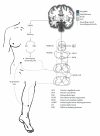Acupuncture to treat primary dysmenorrhea in women: a randomized controlled trial
- PMID: 21799683
- PMCID: PMC3140031
- DOI: 10.1093/ecam/nep239
Acupuncture to treat primary dysmenorrhea in women: a randomized controlled trial
Abstract
We examined the effectiveness of acupuncture to reduce the severity and intensity of primary dysmenorrhea. A randomized controlled trial compared acupuncture with control acupuncture using a placebo needle. Eligible women were aged 14-25 years with a diagnosis of primary dysmenorrhea. Women received nine sessions of the study treatment over 3 months. The primary outcomes were menstrual pain intensity and duration, overall improvement in dysmenorrhea symptoms and reduced need for additional analgesia, measured at 3, 6 and 12 months from trial entry. A total of 92 women were randomly assigned to the intervention (acupuncture n = 46 and control n = 46). At 3 months although pain outcomes were lower for women in the acupuncture group compared with the control group, there was no significant difference between groups. Women receiving acupuncture reported a small reduction in mood changes compared with the control group, relative risk (RR) 0.72, 95% confidence interval (CI) 0.53-1.00, P = .05. Follow-up at 6 months found a significant reduction in the duration of menstrual pain in the acupuncture group compared with the control group, mean difference -9.6, 95% CI -18.9 to -0.3, P = .04, and the need for additional analgesia was significantly lower in the acupuncture group compared with the control group, RR 0.69, 95% CI 0.49-0.96, P = .03, but the follow-up at 12 months found lack of treatment effect. To conclude, although acupuncture improved menstrual mood symptoms in women with primary dysmenorrhea during the treatment phase, the trend in the improvement of symptoms during the active phase of treatment, and at 6 and 12 months was non-significant, indicating that a small treatment effect from acupuncture on dysmenorrhea may exist. In the study, acupuncture was acceptable and safe, but further appropriately powered trials are needed before recommendations for clinical practice can be made.
Figures





References
-
- Dawood MY. Primary dysmenorrhea: advances in pathogenesis and management. Obstetrics and Gynecology. 2006;108(2):428–441. - PubMed
-
- Ylikorkala O, Dawood MY. New concepts in dysmenorrhea. American Journal of Obstetrics and Gynecology. 1978;130(7):833–847. - PubMed
-
- Burnett MA, Antao V, Black A, et al. Prevalence of primary dysmenorrhea in Canada. Journal of Obstetrics and Gynaecology Canada. 2005;27(8):765–770. - PubMed
-
- Hillen TIJ, Grbavac SL, Johnston PJ, Straton JAY, Keogh JMF. Primary dysmenorrhea in young Western Australian women: prevalence, impact, and knowledge of treatment. Journal of Adolescent Health. 1999;25(1):40–45. - PubMed
-
- Harel Z. Dysmenorrhea in adolescents and young adults: etiology and management. Journal of Pediatric and Adolescent Gynecology. 2006;19(6):363–371. - PubMed
LinkOut - more resources
Full Text Sources
Medical

